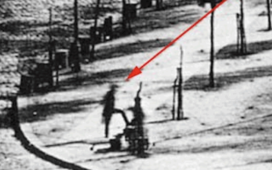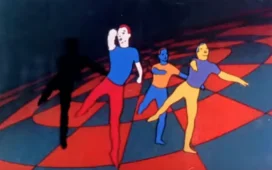https://www.youtube.com/watch?v=playlist
Each of us has a different idea of when, exactly, the sixties ended, not as a decade, but as a distinct cultural period. Some have a notion of the “long sixties” that extends well into the seventies; if pressed for a specific final year, they could do worse than pointing to 1972, when David Bowie made his epoch-shifting appearance as Ziggy Stardust, backed by the Spiders from Mars, on the BBC’s Top of the Pops. It was also the year he released music videos for “Space Oddity,” the single that had begun to make his name at the time of the moon landing in 1969, and “Jean Genie,” the first single from Aladdin Sane, an album inspired in part by the debauchery of the American Ziggy tour he undertook after blasting off into stardom.
Having struggled in the sixties to find a suitable identity and audience, the young Bowie developed an unusually strong understanding of not just the music industry, but also the culture itself. One era was giving way to another, and nobody knew it better than he did. When all those hirsute figures in beards and denim, singing with ostentatious earnestness about love and freedom, disappeared, who would replace them?
In Bowie’s vision, the next phase belonged to clean-shaven, made-up androgynes in flamboyant designer costumes working grand, sometimes science fictional, and often inscrutable themes into what would strike concertgoers as almost complete theatrical experiences — and he would be the first and foremost among them.
Bowie, in other words, made the seventies his own, operating on his knowledge of and instincts about the media environment of that decade and how images would be made in it. By that time, he’d seen too many flashes in the pan of pop music to get complacent about his own prospects for endurance. The reception of “Space Oddity” as a novelty song did its part to motivate him to come up with his bisexual space-alien rock-star alter ego — and to motivate him to terminate that persona on stage in 1973. A couple of years before that, he had already sung of the importance of changes, a kind of manifesto that would guide his career through all the decades that remained. Never would Bowie adhere to a particular musical or aesthetic style for very long, an abiding tendency vividly on display in this playlist of 50 music videos on his official YouTube channel.
The experience of putting out music videos in the seventies placed Bowie well, especially compared to other artists of his generation, to make his mark on MTV in the eighties with a stadium-ready hit like “Let’s Dance.” The nineties found him taking the form in new directions, as with the cinephilically astute video for “Jump They Say” and the daringly action-free visual treatment of the reflective “Thursday’s Child” (from the album Hours…, which began as the soundtrack to the computer game Omikron: The Nomad Soul). Apart from this playlist, his channel also contains music videos for his later songs from the two-thousands and twenty-tens, from “New Killer Star” to “The Stars (Are Out Tonight)” to “Blackstar” — the nature of stardom having been a preoccupation since the beginning, even though he kept on changing to the very end.
Related Content:
Watch David Bowie Star in His First Film Role, a Short Horror Flick Called The Image (1967)
Watch David Bowie’s New Video for “The Stars (Are Out Tonight)” With Tilda Swinton
When Bowie & Jagger’s “Dancing in the Street” Music Video Becomes a Silent Film
Based in Seoul, Colin Marshall writes and broadcasts on cities, language, and culture. His projects include the Substack newsletter Books on Cities and the book The Stateless City: a Walk through 21st-Century Los Angeles. Follow him on the social network formerly known as Twitter at @colinmarshall.















